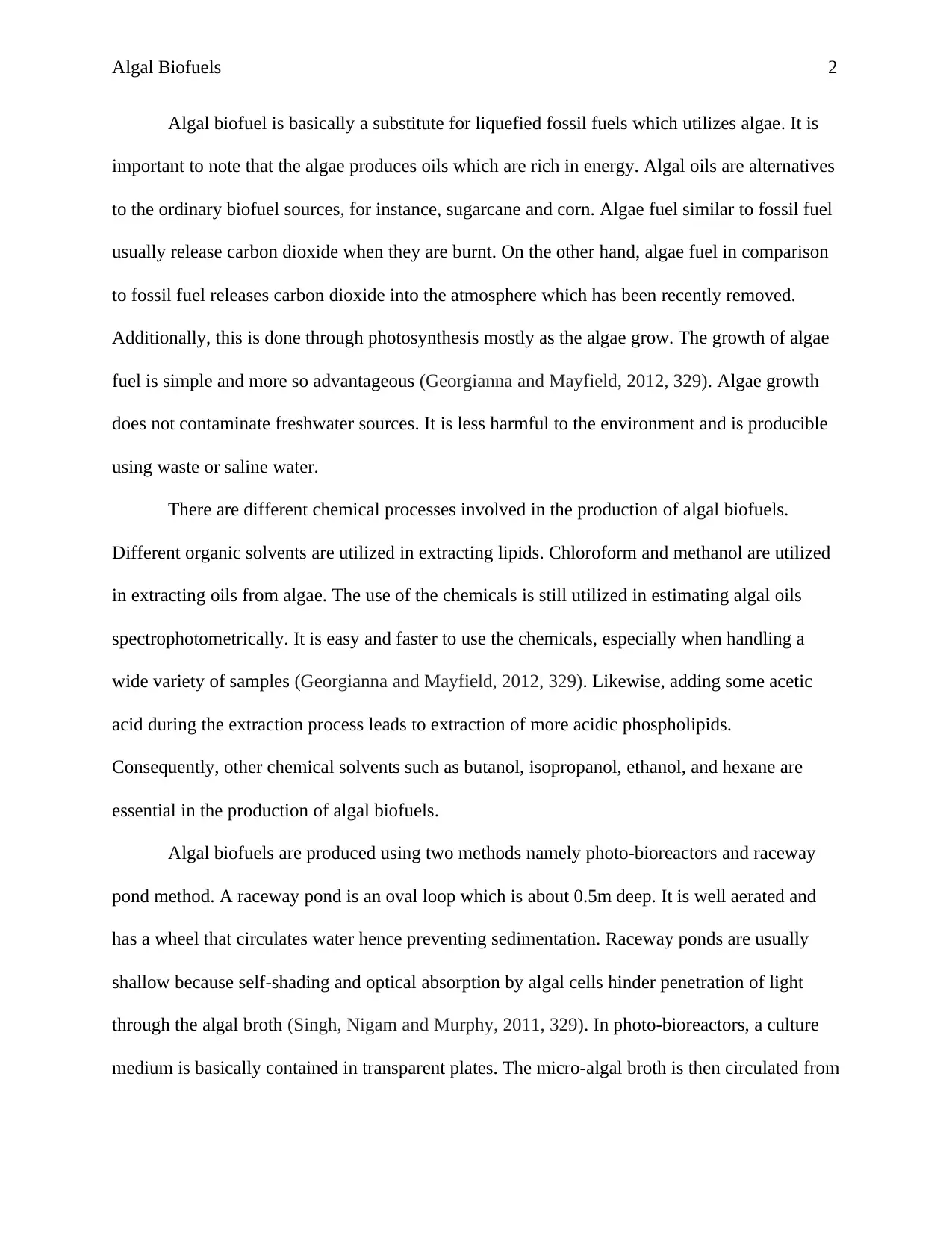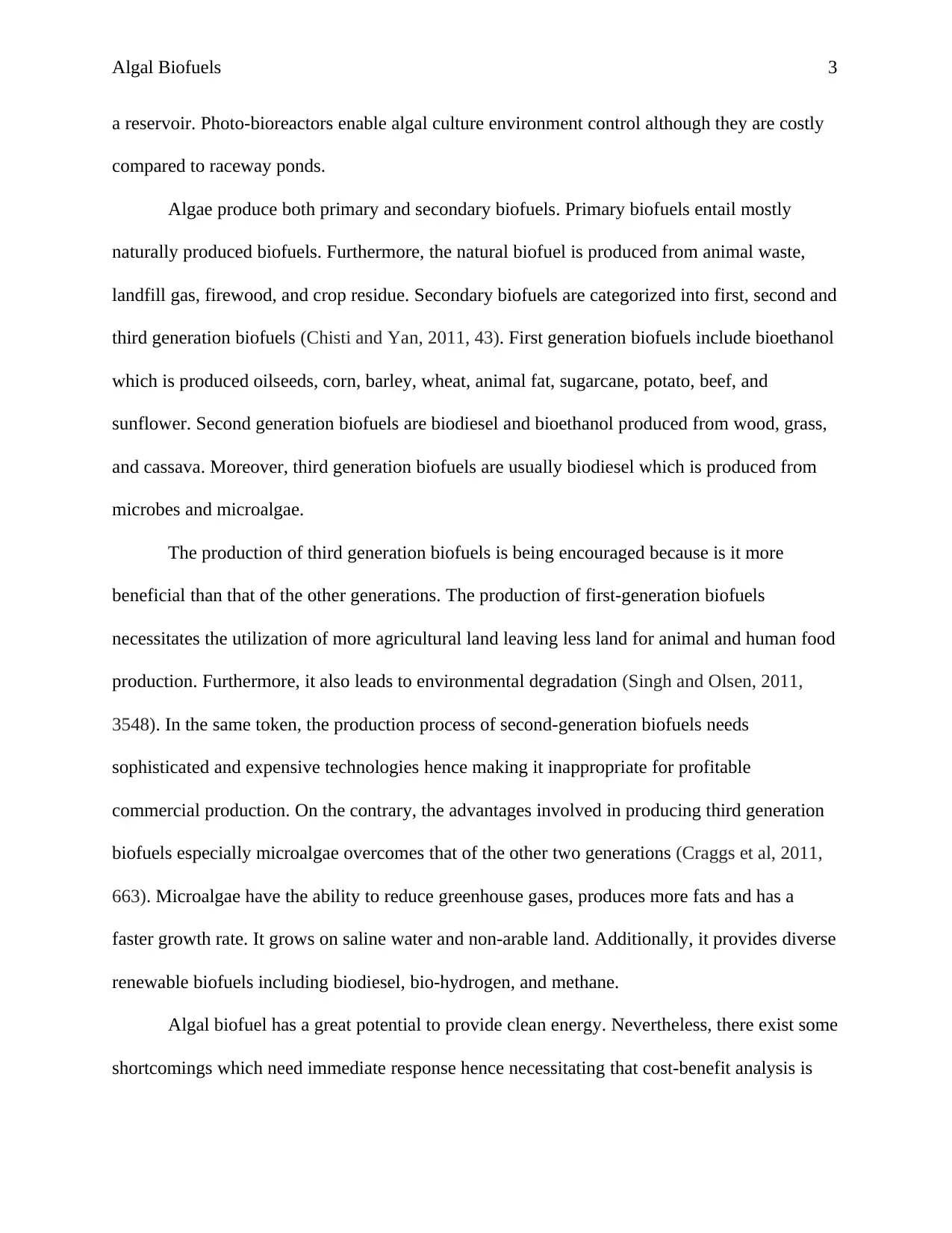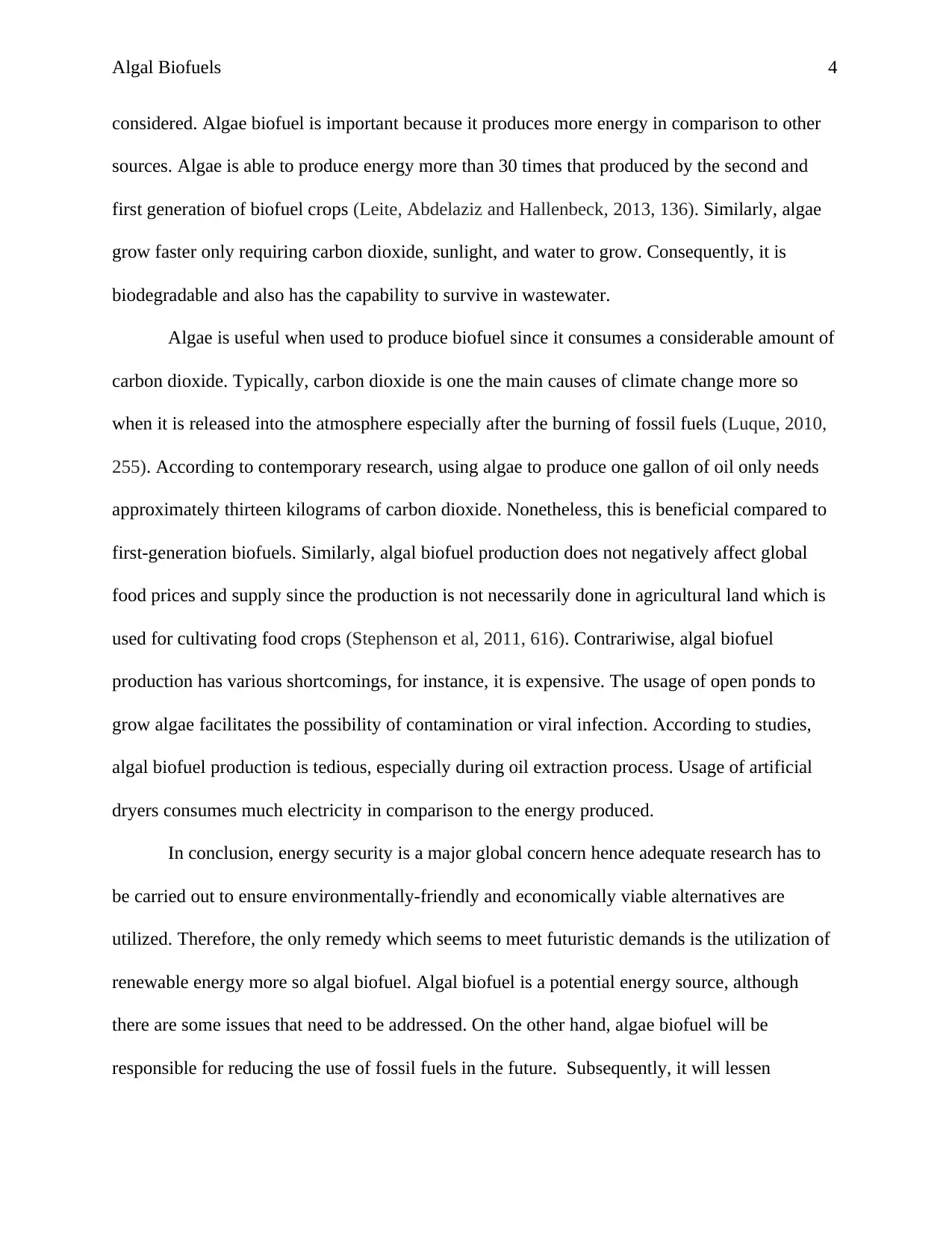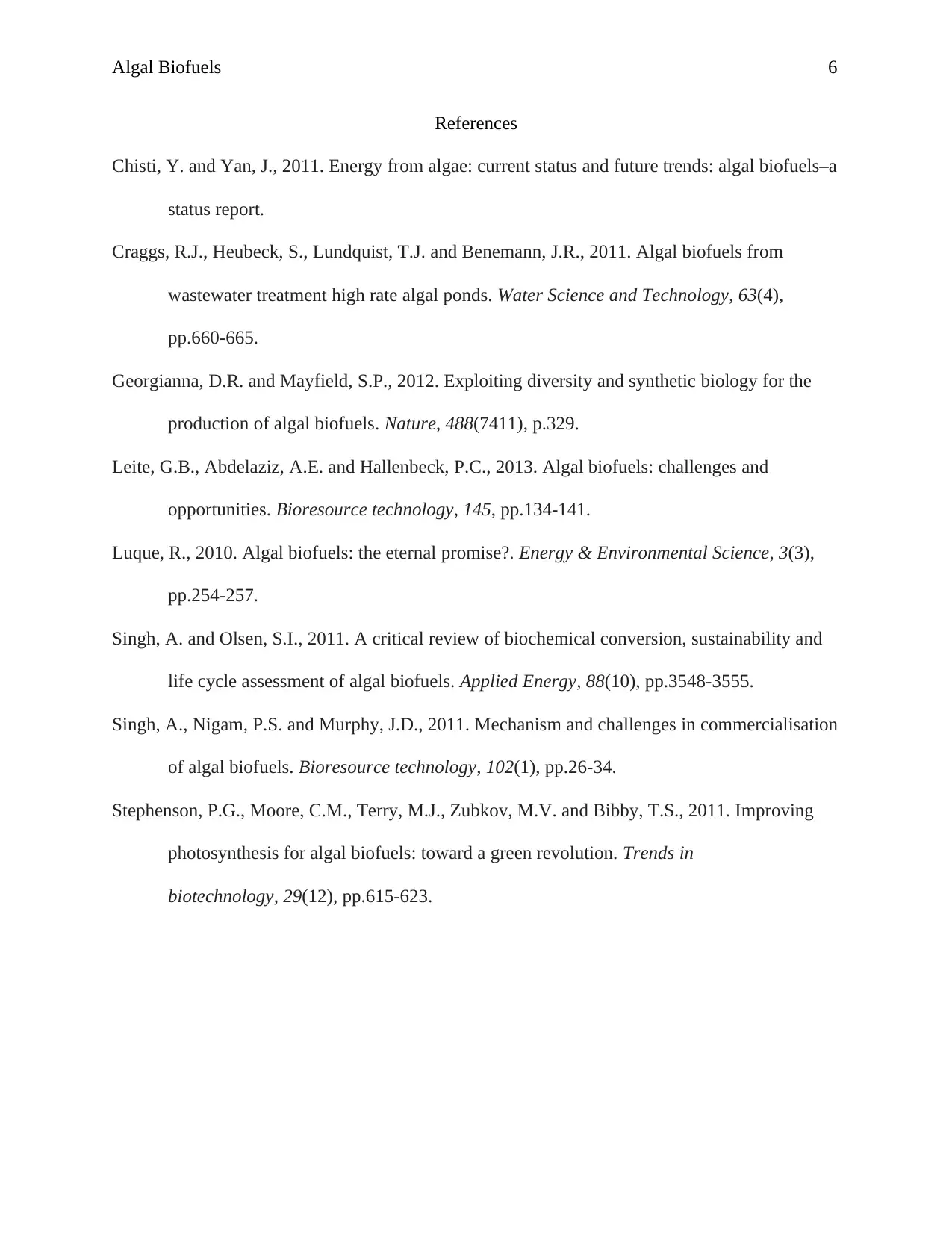Environmental Biotechnology and Algal Biofuels: A Comprehensive Report
VerifiedAdded on 2021/05/31
|6
|1437
|191
Report
AI Summary
This report analyzes algal biofuels as a sustainable alternative to fossil fuels. It discusses the advantages of algal biofuels including their ability to produce more energy, use carbon dioxide, and grow in wastewater. The report details the production methods like photo-bioreactors and raceway ponds, and compares different generations of biofuels, highlighting the benefits of third-generation biofuels derived from microalgae. The report also addresses the challenges of algal biofuel production, such as high costs and potential contamination. It concludes that despite some issues, algal biofuels have great potential for reducing reliance on fossil fuels and mitigating climate change. The report also reviews the chemical processes involved in lipid extraction from algae and the importance of addressing current shortcomings through further research to ensure environmentally-friendly and economically viable alternatives are utilized.

Algal Biofuels 1
Student Name
Environmental Biotechnology
Algal Biofuels
Instructor
University
Date
Student Name
Environmental Biotechnology
Algal Biofuels
Instructor
University
Date
Paraphrase This Document
Need a fresh take? Get an instant paraphrase of this document with our AI Paraphraser

Algal Biofuels 2
Algal biofuel is basically a substitute for liquefied fossil fuels which utilizes algae. It is
important to note that the algae produces oils which are rich in energy. Algal oils are alternatives
to the ordinary biofuel sources, for instance, sugarcane and corn. Algae fuel similar to fossil fuel
usually release carbon dioxide when they are burnt. On the other hand, algae fuel in comparison
to fossil fuel releases carbon dioxide into the atmosphere which has been recently removed.
Additionally, this is done through photosynthesis mostly as the algae grow. The growth of algae
fuel is simple and more so advantageous (Georgianna and Mayfield, 2012, 329). Algae growth
does not contaminate freshwater sources. It is less harmful to the environment and is producible
using waste or saline water.
There are different chemical processes involved in the production of algal biofuels.
Different organic solvents are utilized in extracting lipids. Chloroform and methanol are utilized
in extracting oils from algae. The use of the chemicals is still utilized in estimating algal oils
spectrophotometrically. It is easy and faster to use the chemicals, especially when handling a
wide variety of samples (Georgianna and Mayfield, 2012, 329). Likewise, adding some acetic
acid during the extraction process leads to extraction of more acidic phospholipids.
Consequently, other chemical solvents such as butanol, isopropanol, ethanol, and hexane are
essential in the production of algal biofuels.
Algal biofuels are produced using two methods namely photo-bioreactors and raceway
pond method. A raceway pond is an oval loop which is about 0.5m deep. It is well aerated and
has a wheel that circulates water hence preventing sedimentation. Raceway ponds are usually
shallow because self-shading and optical absorption by algal cells hinder penetration of light
through the algal broth (Singh, Nigam and Murphy, 2011, 329). In photo-bioreactors, a culture
medium is basically contained in transparent plates. The micro-algal broth is then circulated from
Algal biofuel is basically a substitute for liquefied fossil fuels which utilizes algae. It is
important to note that the algae produces oils which are rich in energy. Algal oils are alternatives
to the ordinary biofuel sources, for instance, sugarcane and corn. Algae fuel similar to fossil fuel
usually release carbon dioxide when they are burnt. On the other hand, algae fuel in comparison
to fossil fuel releases carbon dioxide into the atmosphere which has been recently removed.
Additionally, this is done through photosynthesis mostly as the algae grow. The growth of algae
fuel is simple and more so advantageous (Georgianna and Mayfield, 2012, 329). Algae growth
does not contaminate freshwater sources. It is less harmful to the environment and is producible
using waste or saline water.
There are different chemical processes involved in the production of algal biofuels.
Different organic solvents are utilized in extracting lipids. Chloroform and methanol are utilized
in extracting oils from algae. The use of the chemicals is still utilized in estimating algal oils
spectrophotometrically. It is easy and faster to use the chemicals, especially when handling a
wide variety of samples (Georgianna and Mayfield, 2012, 329). Likewise, adding some acetic
acid during the extraction process leads to extraction of more acidic phospholipids.
Consequently, other chemical solvents such as butanol, isopropanol, ethanol, and hexane are
essential in the production of algal biofuels.
Algal biofuels are produced using two methods namely photo-bioreactors and raceway
pond method. A raceway pond is an oval loop which is about 0.5m deep. It is well aerated and
has a wheel that circulates water hence preventing sedimentation. Raceway ponds are usually
shallow because self-shading and optical absorption by algal cells hinder penetration of light
through the algal broth (Singh, Nigam and Murphy, 2011, 329). In photo-bioreactors, a culture
medium is basically contained in transparent plates. The micro-algal broth is then circulated from

Algal Biofuels 3
a reservoir. Photo-bioreactors enable algal culture environment control although they are costly
compared to raceway ponds.
Algae produce both primary and secondary biofuels. Primary biofuels entail mostly
naturally produced biofuels. Furthermore, the natural biofuel is produced from animal waste,
landfill gas, firewood, and crop residue. Secondary biofuels are categorized into first, second and
third generation biofuels (Chisti and Yan, 2011, 43). First generation biofuels include bioethanol
which is produced oilseeds, corn, barley, wheat, animal fat, sugarcane, potato, beef, and
sunflower. Second generation biofuels are biodiesel and bioethanol produced from wood, grass,
and cassava. Moreover, third generation biofuels are usually biodiesel which is produced from
microbes and microalgae.
The production of third generation biofuels is being encouraged because is it more
beneficial than that of the other generations. The production of first-generation biofuels
necessitates the utilization of more agricultural land leaving less land for animal and human food
production. Furthermore, it also leads to environmental degradation (Singh and Olsen, 2011,
3548). In the same token, the production process of second-generation biofuels needs
sophisticated and expensive technologies hence making it inappropriate for profitable
commercial production. On the contrary, the advantages involved in producing third generation
biofuels especially microalgae overcomes that of the other two generations (Craggs et al, 2011,
663). Microalgae have the ability to reduce greenhouse gases, produces more fats and has a
faster growth rate. It grows on saline water and non-arable land. Additionally, it provides diverse
renewable biofuels including biodiesel, bio-hydrogen, and methane.
Algal biofuel has a great potential to provide clean energy. Nevertheless, there exist some
shortcomings which need immediate response hence necessitating that cost-benefit analysis is
a reservoir. Photo-bioreactors enable algal culture environment control although they are costly
compared to raceway ponds.
Algae produce both primary and secondary biofuels. Primary biofuels entail mostly
naturally produced biofuels. Furthermore, the natural biofuel is produced from animal waste,
landfill gas, firewood, and crop residue. Secondary biofuels are categorized into first, second and
third generation biofuels (Chisti and Yan, 2011, 43). First generation biofuels include bioethanol
which is produced oilseeds, corn, barley, wheat, animal fat, sugarcane, potato, beef, and
sunflower. Second generation biofuels are biodiesel and bioethanol produced from wood, grass,
and cassava. Moreover, third generation biofuels are usually biodiesel which is produced from
microbes and microalgae.
The production of third generation biofuels is being encouraged because is it more
beneficial than that of the other generations. The production of first-generation biofuels
necessitates the utilization of more agricultural land leaving less land for animal and human food
production. Furthermore, it also leads to environmental degradation (Singh and Olsen, 2011,
3548). In the same token, the production process of second-generation biofuels needs
sophisticated and expensive technologies hence making it inappropriate for profitable
commercial production. On the contrary, the advantages involved in producing third generation
biofuels especially microalgae overcomes that of the other two generations (Craggs et al, 2011,
663). Microalgae have the ability to reduce greenhouse gases, produces more fats and has a
faster growth rate. It grows on saline water and non-arable land. Additionally, it provides diverse
renewable biofuels including biodiesel, bio-hydrogen, and methane.
Algal biofuel has a great potential to provide clean energy. Nevertheless, there exist some
shortcomings which need immediate response hence necessitating that cost-benefit analysis is
⊘ This is a preview!⊘
Do you want full access?
Subscribe today to unlock all pages.

Trusted by 1+ million students worldwide

Algal Biofuels 4
considered. Algae biofuel is important because it produces more energy in comparison to other
sources. Algae is able to produce energy more than 30 times that produced by the second and
first generation of biofuel crops (Leite, Abdelaziz and Hallenbeck, 2013, 136). Similarly, algae
grow faster only requiring carbon dioxide, sunlight, and water to grow. Consequently, it is
biodegradable and also has the capability to survive in wastewater.
Algae is useful when used to produce biofuel since it consumes a considerable amount of
carbon dioxide. Typically, carbon dioxide is one the main causes of climate change more so
when it is released into the atmosphere especially after the burning of fossil fuels (Luque, 2010,
255). According to contemporary research, using algae to produce one gallon of oil only needs
approximately thirteen kilograms of carbon dioxide. Nonetheless, this is beneficial compared to
first-generation biofuels. Similarly, algal biofuel production does not negatively affect global
food prices and supply since the production is not necessarily done in agricultural land which is
used for cultivating food crops (Stephenson et al, 2011, 616). Contrariwise, algal biofuel
production has various shortcomings, for instance, it is expensive. The usage of open ponds to
grow algae facilitates the possibility of contamination or viral infection. According to studies,
algal biofuel production is tedious, especially during oil extraction process. Usage of artificial
dryers consumes much electricity in comparison to the energy produced.
In conclusion, energy security is a major global concern hence adequate research has to
be carried out to ensure environmentally-friendly and economically viable alternatives are
utilized. Therefore, the only remedy which seems to meet futuristic demands is the utilization of
renewable energy more so algal biofuel. Algal biofuel is a potential energy source, although
there are some issues that need to be addressed. On the other hand, algae biofuel will be
responsible for reducing the use of fossil fuels in the future. Subsequently, it will lessen
considered. Algae biofuel is important because it produces more energy in comparison to other
sources. Algae is able to produce energy more than 30 times that produced by the second and
first generation of biofuel crops (Leite, Abdelaziz and Hallenbeck, 2013, 136). Similarly, algae
grow faster only requiring carbon dioxide, sunlight, and water to grow. Consequently, it is
biodegradable and also has the capability to survive in wastewater.
Algae is useful when used to produce biofuel since it consumes a considerable amount of
carbon dioxide. Typically, carbon dioxide is one the main causes of climate change more so
when it is released into the atmosphere especially after the burning of fossil fuels (Luque, 2010,
255). According to contemporary research, using algae to produce one gallon of oil only needs
approximately thirteen kilograms of carbon dioxide. Nonetheless, this is beneficial compared to
first-generation biofuels. Similarly, algal biofuel production does not negatively affect global
food prices and supply since the production is not necessarily done in agricultural land which is
used for cultivating food crops (Stephenson et al, 2011, 616). Contrariwise, algal biofuel
production has various shortcomings, for instance, it is expensive. The usage of open ponds to
grow algae facilitates the possibility of contamination or viral infection. According to studies,
algal biofuel production is tedious, especially during oil extraction process. Usage of artificial
dryers consumes much electricity in comparison to the energy produced.
In conclusion, energy security is a major global concern hence adequate research has to
be carried out to ensure environmentally-friendly and economically viable alternatives are
utilized. Therefore, the only remedy which seems to meet futuristic demands is the utilization of
renewable energy more so algal biofuel. Algal biofuel is a potential energy source, although
there are some issues that need to be addressed. On the other hand, algae biofuel will be
responsible for reducing the use of fossil fuels in the future. Subsequently, it will lessen
Paraphrase This Document
Need a fresh take? Get an instant paraphrase of this document with our AI Paraphraser

Algal Biofuels 5
greenhouse gases which are responsible for causing climate change.Algal oils are alternatives to
the ordinary biofuel sources, for instance, sugarcane and corn. Algae fuel similar to fossil fuel
usually release carbon dioxide when they are burnt. On the other hand, algae fuel in comparison
to fossil fuel releases carbon dioxide into the atmosphere which has been recently removed.
Algae is useful when used to produce biofuel since it consumes a considerable amount of carbon
dioxide. Typically, carbon dioxide is one the main causes of climate change more so when it is
released into the atmosphere especially after the burning of fossil fuels.
greenhouse gases which are responsible for causing climate change.Algal oils are alternatives to
the ordinary biofuel sources, for instance, sugarcane and corn. Algae fuel similar to fossil fuel
usually release carbon dioxide when they are burnt. On the other hand, algae fuel in comparison
to fossil fuel releases carbon dioxide into the atmosphere which has been recently removed.
Algae is useful when used to produce biofuel since it consumes a considerable amount of carbon
dioxide. Typically, carbon dioxide is one the main causes of climate change more so when it is
released into the atmosphere especially after the burning of fossil fuels.

Algal Biofuels 6
References
Chisti, Y. and Yan, J., 2011. Energy from algae: current status and future trends: algal biofuels–a
status report.
Craggs, R.J., Heubeck, S., Lundquist, T.J. and Benemann, J.R., 2011. Algal biofuels from
wastewater treatment high rate algal ponds. Water Science and Technology, 63(4),
pp.660-665.
Georgianna, D.R. and Mayfield, S.P., 2012. Exploiting diversity and synthetic biology for the
production of algal biofuels. Nature, 488(7411), p.329.
Leite, G.B., Abdelaziz, A.E. and Hallenbeck, P.C., 2013. Algal biofuels: challenges and
opportunities. Bioresource technology, 145, pp.134-141.
Luque, R., 2010. Algal biofuels: the eternal promise?. Energy & Environmental Science, 3(3),
pp.254-257.
Singh, A. and Olsen, S.I., 2011. A critical review of biochemical conversion, sustainability and
life cycle assessment of algal biofuels. Applied Energy, 88(10), pp.3548-3555.
Singh, A., Nigam, P.S. and Murphy, J.D., 2011. Mechanism and challenges in commercialisation
of algal biofuels. Bioresource technology, 102(1), pp.26-34.
Stephenson, P.G., Moore, C.M., Terry, M.J., Zubkov, M.V. and Bibby, T.S., 2011. Improving
photosynthesis for algal biofuels: toward a green revolution. Trends in
biotechnology, 29(12), pp.615-623.
References
Chisti, Y. and Yan, J., 2011. Energy from algae: current status and future trends: algal biofuels–a
status report.
Craggs, R.J., Heubeck, S., Lundquist, T.J. and Benemann, J.R., 2011. Algal biofuels from
wastewater treatment high rate algal ponds. Water Science and Technology, 63(4),
pp.660-665.
Georgianna, D.R. and Mayfield, S.P., 2012. Exploiting diversity and synthetic biology for the
production of algal biofuels. Nature, 488(7411), p.329.
Leite, G.B., Abdelaziz, A.E. and Hallenbeck, P.C., 2013. Algal biofuels: challenges and
opportunities. Bioresource technology, 145, pp.134-141.
Luque, R., 2010. Algal biofuels: the eternal promise?. Energy & Environmental Science, 3(3),
pp.254-257.
Singh, A. and Olsen, S.I., 2011. A critical review of biochemical conversion, sustainability and
life cycle assessment of algal biofuels. Applied Energy, 88(10), pp.3548-3555.
Singh, A., Nigam, P.S. and Murphy, J.D., 2011. Mechanism and challenges in commercialisation
of algal biofuels. Bioresource technology, 102(1), pp.26-34.
Stephenson, P.G., Moore, C.M., Terry, M.J., Zubkov, M.V. and Bibby, T.S., 2011. Improving
photosynthesis for algal biofuels: toward a green revolution. Trends in
biotechnology, 29(12), pp.615-623.
⊘ This is a preview!⊘
Do you want full access?
Subscribe today to unlock all pages.

Trusted by 1+ million students worldwide
1 out of 6
Your All-in-One AI-Powered Toolkit for Academic Success.
+13062052269
info@desklib.com
Available 24*7 on WhatsApp / Email
![[object Object]](/_next/static/media/star-bottom.7253800d.svg)
Unlock your academic potential
Copyright © 2020–2025 A2Z Services. All Rights Reserved. Developed and managed by ZUCOL.
